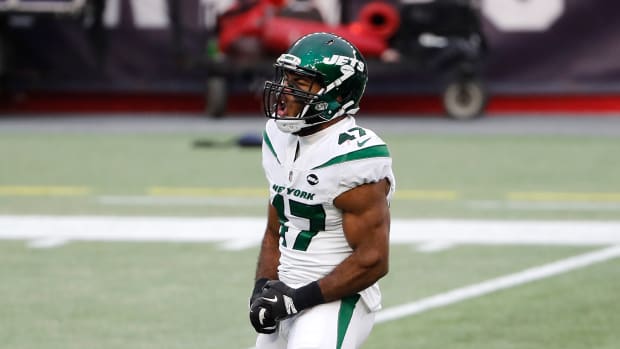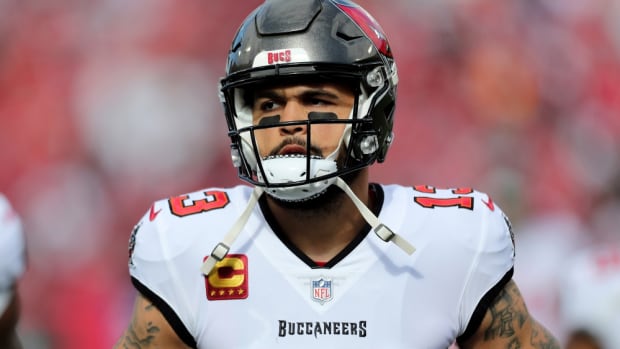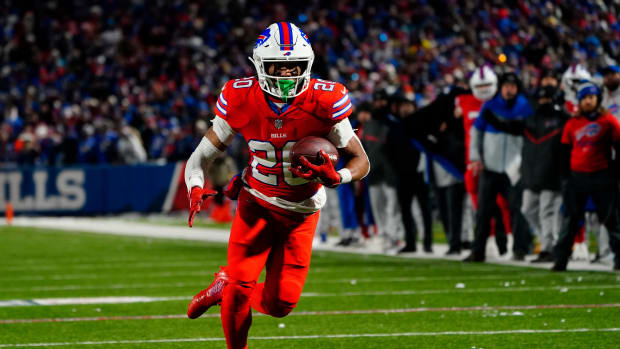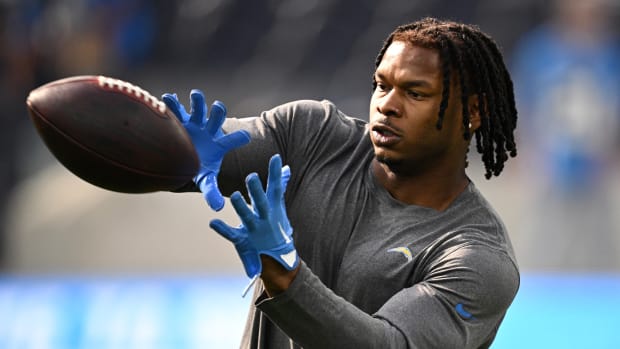
Cardinals Preview: No Such Luck
New head coach, new general manager, new starting quarterback. Same old story in Arizona, where Cardinals’ rebuilding projects have become as familiar as dry heat, cacti and red dirt. No one who had the displeasure of watching the Cardinals last year felt a hint of surprise when coach Ken Whisenhunt and general manager Rod Graves were fired. Arizona’s lack of talent on offense was embarrassing. So was the misuse of the players they did have. Whisenhunt and his staff too often went about their business as if they still had Kurt Warner running the offense.
Usually, a team sells its rebuilding project as a fresh new era led by fresh new faces. The Cardinals don’t quite have that option. First-time general manager Steve Keim has been with this franchise for 14 years. The more public new faces belong to 60-year-old head coach Bruce Arians and 33-year-old quarterback Carson Palmer.
Arians knows about Year One rebuilding efforts from his work in Indianapolis in 2012. The Colts’ season, of course, wound up being unconventional, with head coach Chuck Pagano’s cancer battle and a once-in-a-generation rookie quarterback. Arians, fired in Pittsburgh, was hired as Indianapolis’s offensive coordinator in January 2012 but filled for Pagano for the bulk of the season; Andrew Luck led the Colts to an 11–5 record and a playoff berth, and Arians, in his first stint as an NFL head coach (an interim one at that) was named Coach of the Year.
The rebuilding effort Arians was part of in Indianapolis touched both sides of the ball. In Arizona, the only drastic change on defense is in leadership. Coordinator Ray Horton was unhappy after Keim passed him over for the head coaching job. Now Horton is gone, and Arians hired Philadelphia’s Todd Bowles as his new defensive coordinator. The two know each other from their days at Temple in the ’80s, when Bowles was a team captain and Arians was the head coach. There is understandable skepticism as to whether or not the young assistant can build on Horton’s success with this group.
Of course, it won’t matter what the defense does if substantial improvements don’t come from the rebuilt offense. Arians has said the Cardinals are actually not rebuilding, they’re reloading. It’s all semantics, but when you’re part of a franchise that has had just five winning seasons since 1976, isn’t it better to rebuild than reload?
OFFENSE
Trading a conditional seventh-round pick for Carson Palmer does seem like more of a reloading than a rebuilding move. The latest in a long line of stop-gap veterans under center in the desert, Palmer is unlikely to be a long-term solution. But starting him makes more sense than going with a quarterback from this year’s meek rookie class or believing there’s upside in Drew Stanton or Ryan Lindley.
Serious knee and elbow injuries in past years have taken a little bit off of Palmer’s game. But he still throws a good enough ball. And he has a good enough football IQ to learn and orchestrate Arians’ system right away, which is valuable.
The concern with Palmer is interceptions. He threw 20 with the Bengals in 2010 and 16 after joining the Raiders in Week 7 of 2011. He had 14 picks in 2012, a fair share of which resulted from really bad decisions or ball placement—two issues the occasionally overzealous Palmer has had in recent years.
Carson Palmer (Christian Petersen/Getty)
Expect Palmer’s interception totals to stay in the mid to high teens this season. Arians’ system features a lot of intertwined route combinations outside the numbers and, at the deep-intermediate levels, strongly encourages difficult throws. Last season, Arians’s quarterback, Luck, threw an NFL-high 34% of his passes between 11 and 30 yards downfield.
At least Palmer has something here that he didn’t have in Oakland: a go-to receiver. You can’t ask for more than Larry Fitzgerald, who is undoubtedly champing at the bit after having his talents mostly squandered by subpar quarterbacking in the post-Warner years. Fitzgerald is one of the best in the league at making contested catches. He is also a fine-tuned route runner, which will help his transition to this new system. After aligning mostly as the X-receiver under Whisenhunt, the 10th-year star is now learning to play a Z-receiver (aligned off the line of scrimmage; often the guy who goes in motion) and what the Cardinals call the F-receiver (essentially the slot). This is the same transition Reggie Wayne made under Arians last year.
The question is whether there are enough weapons around Fitzgerald. Arians does a good job manufacturing easy opportunities for receivers through tactics such as bubble screens, pre-snap shifts and motion. But that can only go so far. The Cardinals are counting heavily on Michael Floyd to step up after a quiet rookie season. Ideally, the 2012 first-round pick will earn a starting spot in the base two-tight end sets and allow the darting Andre Roberts to operate primarily from the slot, where he fits best. Disconcertingly, there aren’t any other viable wideouts after these three. The projected No. 4 was supposed to be sixth-round rookie Ryan Swope, but his career is in serious jeopardy due to concussion issues.
Equally important are the tight ends. Arians had two good ones in Pittsburgh and in Indianapolis. Here, at best he’ll have one good one (and maybe none). Eighth-year veteran Jeff King is too stiff to create separation, and there are plenty of unknowns with Rob Housler, a 2011 third-round pick with the bendiness and fluid speed to thrive in this system but just 57 catches to his name.
What is known is that neither King nor Housler is particularly good at blocking. They’re who the Cardinals will have to count on, though, because backups Kory Sperry and Jim Dray are not cut out for regular first-team reps. Arians and new offensive coordinator Harold Goodwin won’t unfairly ask these tight ends to block defensive ends one-on-one as often as the previous regime did, but with such porous offensive tackles up front, tight end blocking will be crucial.
It takes spectacularly awful left tackle play to make fans excited about the return of Levi Brown, but that’s what (now departed) D’Anthony Batiste and Nate Potter gave Arizona last season. All the optimism surrounding Brown, whose 2012 season was lost to a triceps injury, will disappear before October, once people are reminded of the 325-pounder’s plodding footwork and lack of raw power.
Really, Brown should be playing the right tackle spot that limited but improving second-year man Bobby Massie is competing for against respected-but-banged-up veteran Eric Winston. But the Cardinals have no one else to turn to on the left. Daryn Colledge played left tackle at Boise State but doesn’t have the athletic range to do so in the NFL. Colledge is a respectable all-around guard though, which is why he should be able to fend off fourth-round rookie Earl Watford on the right side. Normally, Colledge plays left guard, but that job immediately went to Jonathan Cooper when he became the first guard drafted in the top 10 since 1997 (Chris Naeole, Saints). At center is Lyle Sendlein who, on film, has appeared to struggle with protection calls the past few years. The Cardinals are betting that he’ll be better under Goodwin and new veteran assistant offensive line coach Larry Zierlein.
If Arians really wants to see this offense sprout unexpectedly in 2013, he should consider keeping the ball on the ground a little more than he’s accustomed to doing. Outside of Fitzgerald, this team’s most gifted ball-handlers are running backs Rashard Mendenhall and Ryan Williams. That is, if they’re at full force. The thick-but-shifty Mendenhall was coming off an ACL injury in Pittsburgh last season and wound up being hindered by a litany of other ailments. The explosive but untested Williams missed most of last year with a shoulder injury and all of his 2011 rookie season with a ruptured patella tendon. Mendenhall and Williams both appear healthy now, but for insurance the Cardinals drafted Stepfan Taylor in the fifth round and Andre Ellington in the sixth.
DEFENSE
Despite no major edge-rushing presence, this 3-4 Cardinals defense managed 80 sacks over the past two years (ninth most in the NFL). Much of the credit goes to Horton and the job he did not just crafting aggressive multilevel blitzes but dialing them up at the right times. Bowles will stick with the 3-4, but it remains to be seen whether he’ll have the gumption to order the types of pressures Horton did. When Bowles took over midseason as Philadelphia’s defensive coordinator, he did at least ratchet up a few more blitzes than predecessor Juan Castillo. He also made Cover 3 and Quarters more foundational coverages.
The aggressive nature of Horton’s blitzes often required Arizona’s secondary to play man-to-man. But Cover 3 and Quarters would both be prudent coverages for Bowles, as against most offensive designs they would amount to the cornerbacks playing man on the outside and the safeties having more zone type responsibilities inside.
The Cardinals have one of the top man-cover corners in Patrick Peterson. He endured a bit of a sophomore slump last season but still showed the raw strength and recovery speed that could make him the best cornerback in football. Opposite Peterson, there’s a competition between two newcomers: Antoine Cason, a willowy former Chargers first-round pick who is looking to start anew after losing his confidence over the last two years, and Arians’ former Colt Jerraud Powers. Cason signed a one-year, $1.5 million contract but can be viable starting on the outside. Powers, who signed for three years, $10.5 million, has good strength near the line of scrimmage and can play outside or in the slot. Competing for dime duties behind these two are last year’s fourth-round pick, Jamell Fleming, and former Chiefs slot corner Javier Arenas.
As for the safeties, going with inside zone coverages is necessary given Rashad Johnson’s limited range and Yeremiah Bell’s age (35). The hope is that Bell’s veteran savvy can help prevent Johnson from making the type of misreads that have kept him in a backup role for most of his four-year career. Don’t be surprised if controversial third-round rookie Tyrann Mathieu pushes Johnson for the starting job. Mathieu could bring much-needed playmaking potential to centerfield and allow Bell to play strong safety.
The Cardinals have one of the top man-cover corners in Patrick Peterson. His raw strength and recovery speed could make him the best cornerback in football.
The tenuousness at safety is mitigated somewhat by a strong and deep interior linebacking corps. It was wise of Keim to bring back Karlos Dansby after his release from Miami. Dansby is not as athletic as he once was, but at 31 he’s nowhere near washed up. He shouldn’t have much trouble beating out the more physical but less agile Jasper Brinkley for a starting job. At the very least he’ll take meaningful snaps away from Brinkley in nickel.
With Daryl Washington suspended the first four games, the other starting inside spot could initially be filled by second-round rookie Kevin Minter, whom scouts like as a run defender but have questions about in coverage. Washington’s suspension is for violating the league’s substance abuse policy. He’s also facing two counts of aggravated assault stemming from a domestic dispute with his girlfriend in May.
Washington’s absence hurts the front seven. Not only does he have some of the best pure speed of any linebacker in football, he’s one of the game’s best interior blitzers. He had a startling eight sacks in the first eight games last season (and finished with nine for the year). That made up for the mediocrity of outside linebackers Sam Acho and O’Brien Schofield. To challenge those former fourth-round picks, the Cards drafted Alex Okafor— in the fourth round, of course. The 264-pounder played defensive end at Texas and may need some time to learn a new position. That’s why, in late July, the Cardinals brought in John Abraham (eventually cutting Schofield to make room); Abraham is 35 and will have to acclimate to a standup role, but still has enough edge speed to be Arizona’s best pass-rusher.
Also challenging for snaps on the outside is free-agent pickup Lorenzo Alexander. The seventh-year pro thrived as a special-teamer and a versatile utility backup with the Redskins, but he doesn’t have the initial quickness to be a veritable edge-rusher. His 2.5 sacks last season were a career-high.
Darnell Dockett (Matt York/AP)
Making up for the unappealing outside linebacking options is the most dynamic duo of 3-4 ends in football, Darnell Dockett and Calais Campbell. Both are fierce athletes—Dockett for his initial quickness and violent hands, Campbell for his pterodactyl-like wingspan and supple strength. They can wreak havoc lined up from anywhere along the edges regardless of whether they’re playing one-gap or two-gap. Both are excited about Bowles’ plans to feature them more as attackers than cloggers.
There have been just a few occasions where Dockett’s and Campbell’s relentless playing style left them vulnerable to fatigue against hurry-up offenses and late in games. That shouldn’t be an issue this year, as Keim augmented the front line depth by signing Matt Shaughnessy and Frostee Rucker to one-year contracts. Both have played predominantly in a 4-3 but are good fits as backups in this hybrid front.
At nosetackle, Dan Williams has finally shown some improvement against the run, anchoring against smaller centers and getting off blocks versus moving lines. That said, he’ll never be the next Sam Adams, which is why third-year backup David Carter must continue to grow. Carter was used more as a utility piece last season, playing five-technique and defensive tackle, but the depth added in free agency could keep him more confined to nose duties this year.
SPECIAL TEAMS
Thirty-seven-year-old journeyman Jay Feely remains one of the most reliable kickers in the business. Same goes for 34-year-old punter Dave Zastudil. On punt returns, Patrick Peterson scares opponents the same way Devin Hester does. However, after four touchdown returns as a rookie, Peterson failed to register a return over 30 yards last year. He also had some problems with fumbling. If he somehow regresses this season, newcomer Javier Arenas could get a look on punts. As for kick return duties, the job is up for grabs.
BOTTOM LINE
This is the least-talented team in the NFC West, though it’s better than the club that went 5-11 last year. Even if Palmer can steady the offense, it remains to be seen how this overachieving defense will respond to a new coordinator.
Andy Benoit is diving deep into each team’s prospects for 2013. Read what he’s done so far.






































